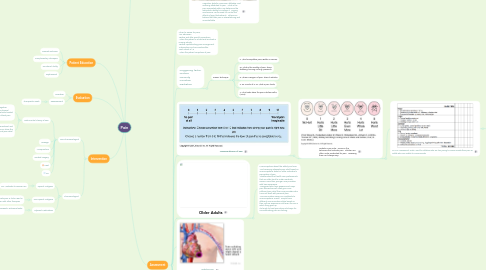
1. Intervention
1.1. Non-Pharmacological
1.1.1. Gate Control Theory of Pain
1.1.1.1. Pain has emotional and cognitive components in addition to physical sensations. Gating Mechanisms located along the CNS regulate or block pain impulses
1.1.1.1.1. *Gate is open: the pain impulse passes through
1.1.1.1.2. *Gate is closed: the pain impulse is blocked because the gate is closed
1.1.1.2. If we use the physiological, emotional and cognitive influences then we can close the gate with non-pharmacological pain-relief interventions
1.1.2. Massage
1.1.3. Accupuncture
1.1.4. Guided Imagery
1.1.5. Heat
1.1.6. Ice
1.2. Pharmacological
1.2.1. Opioid Analgesia
1.2.1.1. For Moderate to Severe Pain
1.2.1.1.1. Proper use – given until pain relief is achieved. Larger dose – sedation, Even larger dose – effects on CNS to include breathing support Ex. Narcotics, percocet, Norco
1.2.2. Non-opioid Analgesia
1.2.2.1. For Moderate pain or to be used in conjunction with other therapies
1.2.2.1.1. NSAID, ASA
1.2.3. Adjuvant Medications
1.2.3.1. NSAIDS, antidepressants, anticonvulsants, corticosteroids
2. Evaluation
2.1. Overdose
2.2. Reassessment
2.2.1. Therapeutic Goals
3. Patient Education
3.1. Desired Outcome
3.2. Complimentary Therapies
3.3. Functional Ability
3.4. Psychosocial
4. Subjective Experience
4.1. Pain is sensory, emotional, cognitive, and behavioral components that are interrelated with environmental, developmental, sociocultural and contextual factors.
4.2. Physiologic (Sensory) Pain: How the individual recognizes and describes pain
4.3. Affective: Emotional response. (anger, fear, depression)
4.4. Behavioral: Observable actions used to express pain (facial expressions, change in behavior- for those that are unable to express pain, social isolation)
4.4.1. Intubated Patient
4.5. Cognitive: beliefs, memories, attitudes, and meaning attributed to pain. What is the pain associated with? May determine the individual's ability to manage it. Coping mechanisms can be used co control the effects of pain (distractions). Others can believe that their pain is overwhelming and uncontrollable
5. Assessment
5.1. When to assess for pain? -On admission -Before and after painful procedures -When the patient is at rest and involved in nursing activity -Before implementing pain management -intervention and 30 minutes after. -Each check of VS -When the patient complains of pain
5.2. -Triggering factor -Nature -Severity -Location -Radiation
5.2.1. PQRST technique
5.2.1.1. P: What Precipitates pain? Better or worse?
5.2.1.2. Q: What is the Quality of pain: sharp, stabbing, burning, aching, pressure?
5.2.1.3. R: Where is Region of pain- does it radiate?
5.2.1.4. S: on a Scale of 0-10, What is pain level?
5.2.1.5. T: What Tasks does the pain interfere with? (ADLs)
5.3. Assessing degree of pain
5.3.1. Pediatric Pain Scale: Focus on the behaviors that indicate pain. Children are often under medicated for pain. Assessing them isn't always easy.
5.3.1.1. FLACC Assessment Scale- used for children who are too young to communicate their pain or adults who are unable to communicate
5.3.1.1.1. Universal Pain Assessment
5.4. Older Adults
5.4.1. Misconceptions about the Elderly and Pain -Not receiving adequate pain relief based on misconceptions about an older individual's perception of pain -Studies show that health care professionals that are older tend to under-medicate seniors more than younger care providers with less experience. -Caregivers who have experienced major pain themselves will often give more sufficient pain relief than care providers who have not dealt with personal pain. -Communication issues can contribute to misconceptions as well. People have different communication styles based on their culture, experience and even the era in which they grew up. It’s tough to treat pain when solid ways for communicating pain are lacking
5.5. Radiating Pain
5.6. Classifying Pain
5.6.1. Nociceptive Pain: Caused by harmful stimuli being detected by nociceptors (peripheral nerve endings)
5.6.1.1. Types of Nociceptive Pain:
5.6.1.1.1. Somatic: well-localized. Described as dull, achy, throbbing
5.6.1.1.2. Visceral: poorly-localized. Described as squeezing, pressure, distention
5.6.2. Neuropathic Pain
5.6.2.1. Damage to peripheral nerves or CNS
5.6.2.1.1. Described as Numbing, Burning, Shooting, Stabbing
5.6.3. Phantom Pain
5.6.4. Psychogenic Pain: occurs in people with mental illness or severe emotional trauma. There is no known physical cause but processing of sensitive information in CNS is disturbed
5.7. Acute and Chronic
5.7.1. Acute Pain: Can be attributed to something specific
5.7.1.1. Duration: lasts for a period, and when the body heals, or the underlying cause is treated, the pain stops.
5.7.2. Chronic Pain: No relief, persistent, can be disabling
5.7.2.1. Duration: longer than 3 months or past time that relief should be felt
5.8. Neonates
5.8.1. Difficult to assess....yes they do experience pain
5.8.2. Numerous symptoms that MAY be related Crying Lethargy Hypertension Hypotension Tachycardia
